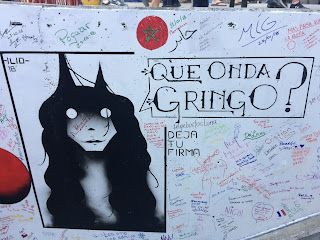Today we signed ourselves up for a pair of ambitious walking tours around the city--fortunately the merciful 75˚F high for the day meant that we wouldn't get too roasted in the sun.
We started off at the Poblado metro station to meet our guide, Camilo of Real City tours. They were recommended to us multiple times by many different parties. After a metro ride to downtown, we checked out the administrative buildings in the city center. The place is abuzz with employees headed to work and students commuting.
We learn that the Paisas (Natives of the department/state of Antioquia) are fiercely proud of their heritage, and often consider themselves Paisa first, Colombian second.
Casmilo explains artfully a basic history of Colombia, from Columbus to the Industrial Revolution. He also carefully addresses our curiosities about "the famous criminal" or "Voldemort", as he calls Pablo Escobar. He doesn't want to say his name, since locals who don't understand English may be given the wrong impression of the tour that it's simply pandering to gawkers at dark chapter in a nation's history. Similarly, he explains that cocaine is seen as a blight one society, and that it destroys the environment as well as peoples lives. The cartels are nearly universally despised.
Milo then takes us through the busy city streets, showing how they have been reclaimed from crime and violence by 'democratic architecture'. Libraries and public squares have been built over old crime dens.
We started off at the Poblado metro station to meet our guide, Camilo of Real City tours. They were recommended to us multiple times by many different parties. After a metro ride to downtown, we checked out the administrative buildings in the city center. The place is abuzz with employees headed to work and students commuting.
 |
| An enormous brutalist statue documents the history of Paisas in the middle of the administrative area. |
We learn that the Paisas (Natives of the department/state of Antioquia) are fiercely proud of their heritage, and often consider themselves Paisa first, Colombian second.
Casmilo explains artfully a basic history of Colombia, from Columbus to the Industrial Revolution. He also carefully addresses our curiosities about "the famous criminal" or "Voldemort", as he calls Pablo Escobar. He doesn't want to say his name, since locals who don't understand English may be given the wrong impression of the tour that it's simply pandering to gawkers at dark chapter in a nation's history. Similarly, he explains that cocaine is seen as a blight one society, and that it destroys the environment as well as peoples lives. The cartels are nearly universally despised.
Milo then takes us through the busy city streets, showing how they have been reclaimed from crime and violence by 'democratic architecture'. Libraries and public squares have been built over old crime dens.
 |
| Square of Light, with illuminated poles at night. This used to be a slum. |
We also learned that hookers often advertised on the streets near churches in a curious symbiosis fueled by Catholic guilt.
We walked past many beautiful bronze Botero sculptures, with chunky features.
 |
| Alex and a Botero pooch |
We finished nearly 4 hours later near two identical Boetero sculptures of a bird, with one blown open by a bomb. The destroyed sculpture was kept as a stark reminder of the city's recent and bloody past, while its re-cast replacement serves as a portent for new peace and prosperity for the city and its inhabitants.
Camilo implores us to share this story with friends and family to help increase Colombia's tourism. It deserves it. This country is amazingly friendly, affordable, and extremely beautiful. Not to mention quite safe.
After completing this tour, we make our way via metro to San Javier station on the west side of the city via Metro for our tour of Comuna Trece (Community 13). This was an extremely violent neighborhood 20 years ago, but has since recovered and flourished with help from the city.
Now the place is home to a beautiful display of graffiti by local artist. They're celebrating hope and colorful barrio life. Ice-cream sellers operate storefronts out fo their homes. Break dancers perform for visitors, and kids ride bicycles up and down the gracefully inclined ramps that line the hillside through the tight houses on the hill. Escalators assist in mobility up and down.
After the tour, Alex and I catch one of the metrocable cars to fly over some of Medellín's outskirts. These project have integrated poor neighborhoods into the city fabric to everyone's benefit.
These scenes are a far cry from the violent neighborhood that 20 years ago prevented resident's employment if they disclosed where they lived.
In the evening after the tour, Alex and I meet Kim, Casey, Geri, and my other EWB buddy, Devin. Devin's currently living in Medellín developing his own apps. Geri invited us to a Colombian craft beer festival at Mercado Del Rio. The place is a super nice food court of restaurants from around the world, assembled as an after-work meeting spot for employees of nearby Bancolombia.
 |
| Devin, me, Alex, Casey, and Kim at the Colombian craft beer festival |
Some of the beers, especially those from Kashmir brewing were inventive and delicious--they had various kinds infused with coffee and other flavors. Another brewer had a delicious corn beer that almost tasted like whiskey.
Dinner was paella and three different kinds of ceviche. I was in heaven. We finished off the night with Hive and beers at the hotel.





No comments:
Post a Comment